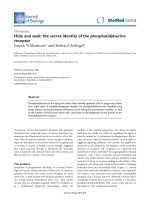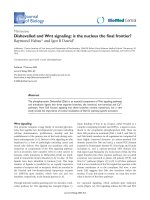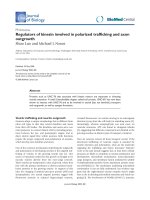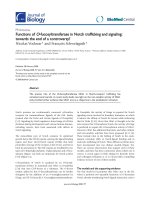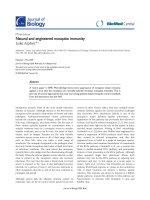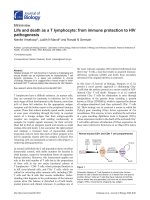Báo cáo sinh học: " Starvation and desiccation tolerance in Drosophila melanogaster: differences between European, North African and Afrotropical populations" potx
Bạn đang xem bản rút gọn của tài liệu. Xem và tải ngay bản đầy đủ của tài liệu tại đây (662.99 KB, 11 trang )
Original
article
Starvation
and
desiccation
tolerance
in
Drosophila
melanogaster:
differences
between
European,
North
African
and
Afrotropical
populations
JL
Da
Lage
P
Capy
JR
David
CNRS,
Laboratoire
de
Biologie
et
Génétique
Evolutives,
’
91198
Cif sur-Yvette
Cedex,
!1-ance
(Received
5
January
1990;
accepted
13
July
1990)
Summary -
Starvation
tolerance
(mean
survival
time
with
water
only)
and
desiccation
tolerance
(mean
survival
with
no
food
and
zero %
humidity)
were
measured
at
17°C
in
adult
flies
from
3
different
geographic
populations
living
in
different
climates.
A
fairly
large
uncontrolled
variability
was
observed
and
two
successive
generations
of
the
various
isofemale
lines
were
investigated
for
each
population.
For
desiccation
tolerance,
a
Tunisian
population
from
an
oasis
was
found
to
be
more
tolerant
than
French
or
Congolian
populations.
For
starvation
tolerance,
the
survival
of
the
Congolian
population
was
about
twice
the
values
found
for
French
or
Tunisian
flies.
It
is
suggested
that
the
Afrotropical
flies
which
live
in
a
hot,
humid
environment,
are
poorly
protected
against
desiccation
but
need
a
high
starvation
tolerance
because
of
their
high
metabolic
rate
due
to
the
high
ambient
temperature.
Drosophila
melanogaster
/
geographic
race
/
ecological
genetics
/
environmental
stress
Résumé —
Tolérance
à
l’inanition
et
à
la
dessiccation
chez
Drosophila
melanogaster :
différences
entre
populations
d’Europe,
d’Afrique
du
Nord
et
d’Afrique
tropicale.
La
tolérance
à
l’inanition
(durée
de
survie
en
présence
seulement
d’eau)
et
la
tolérance
à
la
dessiccation
(durée
de
survie
sans
nourriture
en
atmosphét!e
sèche)
ont
été
étudiées
à
170 C
sur
des
mouches
adultes
provenant
de
9 régions
géographiques.
Une
assez
forte
variabilité
non
contrôlée
a
été
observée
et
2
générations
successives
ont
été
étudiées
pour
les
diverses
lignées
isofemelles
de
chaque
population.
Pour
la
tolérance
à
la
dessiccation,
la
population
tunisienne
provenant
d’une
oasis
a
été
trouvée
plus
tolérante
que
les
populations
de
France
ou
du
Congo.
Pour
la
résistance
à
l’inanition,
la
population
du
Congo
est
environ
2 fois
plus
tolérante
que
les
populations
de
France
ou
de
Tunisie.
Il
est
proposé
que
les
populations
d’Afrique
tropicale,
qui
vivent
dans
un
environnement
chaud
et
humide,
sont
peu
protégées
contre
la
dessiccation
mais
qu’elles
ont
besoin
d’une
forte
résistance
à
l’inanition,
compte
tenu
du
fait
que
la
chaleur
ambiante
leur
impose
un
métabolisme
élevé.
Drosophile
/
race
géographique
/
génétique
écologique
/
stress
dû
à
l’environnement
*
Correspondence
and
reprints
INTRODUCTION
During
the
last
decade,
attention
has
been
drawn
to
the
possible
significance
of
abiotic
environmental
stress
for
the
evolutionary
biology
of
Drosophila
species
(David
et
al,
1983;
Parsons,
1983,
1987).
Climatic
environmental
stress
differs
considerably
according
to
geographic
parameters
and
significant
variations
between
populations
are
more
likely
to
be
found
in
species
with
a
broad
geographic
range.
In
this
respect,
D
melanogaster,
which
proliferates
both
in
temperate
and
tropical
countries
(David
and
Tsacas,
1981;
David
and
Capy,
1988)
has
become
an
excellent
model
for
checking
local
adaptations.
Drosophila
adults
are
poorly
protected
against
desiccation
(David
et
al,
1983)
and
the
water
balance
is
maintained
by
water
ingestion
(Fairbanks
and
Burch,
1970;
Arlian
and
Eckstrand,
1975).
In addition
the
availability
of
resources
is
variable
among
localities
and
seasons,
and
the
demography
principally
depends
on
two
parameters,
ie
resources
and
favorable
temperature
(David
et
al,
1983;
David
et
al, 1984).
Variations
in
desiccation tolerance
have
been
mainly
investigated
in
Australian
natural
populations
(Parsons,
1980;
Stanley
and
Parsons,
1981;
Davidson,
1988,
1989).
Temperate
populations
were
found
to
be
more
resistant
to
desiccation
stress
than
populations
from
subtropical
regions,
in
agreement
with
what
could
be
expected
from
consideration
of
local
climates.
Recent
investigations
(Hoffman
and
Parsons,
1989a,b)
have
suggested
that
tolerance
to
different
stress
could
be
mediated
by
the
same
basic
physiological
process,
namely
a
lower
resting
metabolic
rate.
According
to
this
hypothesis,
we
may
expect
that
starvation
tolerance,
which
depends
on
the
amount
of
available
reserves,
and
especially
of
lipids
(David
et
al,
1975)
could
also
be
related
to
a
lower
metabolic
rate
and
to
other
environmental
stress
(Hoffmann
and
Parsons,
1989a).
However,
starvation
tolerance
has
been
mainly
investigated
for
its
physiological
significance
(David
et
al,
1975;
Da
Lage
et
al,
1989)
and
for
comparing
artifically
selected
lines
(Service
et
al,
1985;
Service,
1987;
Hoffmann
and
Parsons,
1989b)
while
natural
populations
are
poorly
documented.
In
a
previous
paper
(David
and
Capy,
1988),
we
suggested
that,
with
respect
to
their
history,
natural
populations
of
D
medanogaster
could
be
divided
into
three
groups :
1)
ancestral
populations
found
in
the
Afrotropical
region
south
of
the
Sahara;
2)
&dquo;old&dquo;
or
&dquo;ancient&dquo;
populations,
established
independently
of
the
activity
of
modern
man,
and
found
in
the
Eurasian
continent;
3)
&dquo;new&dquo;
or
&dquo;recent&dquo;
populations,
introduced
by
man
a
few
centuries
ago
and
found
in
America
and
Australia.
Desiccation
tolerance
studies
have
focused
on
such
recent
populations,
while
almost
nothing
is
known
of
more
ancient
populations.
In
the
present
study,
we.have
compared
three
types
of
populations
from
different
latitudes
and
living
under
very
different
climatic
conditions.
Using
the
isofemale
line
technique,
we
have
simultaneously
studied
for
each
line
the
desiccation
and
starvation
tolerance
by
measuring
adult
survival
in
dry
and
humid
conditions.
MATERIALS
AND
METHODS
Three
natural
populations
were
compared.
An
equatorial
African
population
from
Loua
near
Brazzaville
(Congo)
living
all
year
round
in
a
humid,
warm
and
favorable
environment.
A
North
African
population
from
a
Tunisian
oasis
(Nasrallah
near
Kairouan)
exposed
each
year
to
strong
heat-desiccation
stress
during
the
Summer
months,
as
is
typical
of
all
Mediterranean
climates.
A
population
from
southern
France,
represented
by
two
samples,
Moulis
and
Lorp,
two
localities
a
few
kilometers
apart
from
St-Girons
near
Toulouse.
This
population
lived
under
a
cool
temperate
climate
without
any
strong
desiccation
stress
but
faced
the
difficult
problem
of
overwintering
during
the
coldest
months
of
the
year.
Samples
were
collected
using
either
banana
fermenting
baits
or
by
sweeping
over
natural
breeding
sites,
ie
Opu!tia
fruits
in
Tunisia
or
manihot
peelings
in
Congo.
In
each
case,
wild
collected
females
were
used
to
initiate
isofemale
lines.
These
lines
were
kept
in
the
laboratory
for
a
number
of
generations
ranging
between
5
and
12
before
the
experiments
were
undertaken.
Population
size
in
each
line
was
always
more
than
20
flies
for
each
generation.
Starvation
and
desiccation
tolerance
was
studied
by
measuring
the
survival
duration
of
adult
flies
kept
without
food.
With
the
isofemale
line
technique,
male
and
female
data
are
correlated
(David,
1979)
since
both
sexes
of
each
line
exhibit
a
genetic
similarity
and,
moreover,
are
submitted
to
a
common
environment;
therefore
only
males
were
compared
for
the.3
3 geographic
populations.
The
experimental
procedures
have
been
described
in
a
previous
paper
(Da
Lage
et
al,
1989)
and
are
summarized
here.
For
each
line,
the
larvae
were
grown
on
a
killed
yeast,
high
nutrient
medium
(David
and
Clavel,
1965).
On
emergence,
adults
were
etherized
and
distributed
into
groups
of
10
flies.
Each
group
of
10
was
fed
on
killed
yeast
medium
for
2
or
3
days
and
then
transferred
to
the
experimental
vials.
For
starvation
tolerance,
water
was
provided
in
each
vial.
For
desiccation
tolerance,
a
relative
humidity
of
0%
was
maintained
with
silica
gel.
Experiments
were
made
at
17°C
since,
at
this
temperature,
the
survival
time
is
longer
so
that
the
mean
value
is
calculated
with
better
precision.
For
each
isofemale
line
and
treatment,
two
independent
vials,
ie
20
males,
were
studied.
The
repeatability
of
the
measurements
was
assessed,
by
studying
two
successive
generations
for
each
population.
Early
in
the
trials
it
was
apparent
that
repeatability
was
not
excellent,
as
is
often
the
case
with
physiological
traits
(Carton
et
al,
1989;
Da
Lage
et
al,
1989),
so
that
considering
the
results
at
the
individual
level
would
be
almost
meaningless.
In
most
of
the
following
analyses,
the
mean
of
each
line
is
considered
as
the
basic
observation,
and
the
variability
between
lines will
mainly
be
used
for
calculating
the
standard
error
of
the
mean
of
each
population.
RESULTS
Survival
time
in
dry
and
humid
conditions
The
mean
survival
durations
of
the
various
populations
are
given
in
Table
I.
As
expected
(Da
Lage
et
al,
1989),
life
duration
is
always
much
less
under
desiccating
conditions,
showing
the
specific
effects
of
the
desiccation
stress.
With
one
exception
(starvation
tolerance
of
the
Tunisian
population),
the
differences
between
the
two
successive
generations
were
not
significant.
In
the
case
of
the
Tunisian
population,
a
third
generation
was
studied
and
the
following
average
values
(in
hours)
were
obtained :
m
=
31.22f1.01
(n
=
30)
for
desiccation
tolerance,
and
m
=
75.41t2.91
(n
=
25)
for
starvation
tolerance.
Compared
to
table
I
values,
we
find
that
desiccation
tolerance
is
significantly
lower
than
in
the
first
two
generations,
while
for
starvation
tolerance,
the
mean
is
intermediate
and
not
significantly
different
from
the
other
two.
These
fluctuations
illustrate
the
possible
low
repeatability
of
some
results,
due
to
uncontrolled
variations
in
the
experimental
conditions.
For
the
Tunisian
population,
the
mean
life
duration
in
dry
conditions
of
the
3
generations
is
36.8
h;
the
true
value
could
be
a
little
higher
(38-39
h)
if
we
admit
that
the
third
generation
was
submitted
to
some
uncontrolled,
unfavorable
effects.
For
starvation
tolerance,
on
the
other
hand,
the
mean
value
of
the
3
generations,
ie
76
h,
may
be
considered
as
the
best
estimate
for
that
population.
For
each
generation
and
population,
a
one-way
ANOVA
(data
not
shown)
indicated
that
the
between
line
variance
was
always
significantly
higher
than
the
within
line
variance.
Such
a
result
is
often
considered
to
be
an
indication
of
the
occurrence
of
genetic
variations
between
lines
(Hoffmann
and
Parsons,
1988;
Carton
et
al,
1989;
Capy
et
al,
1990).
A
way
to
appreciate
the
amount
of
variation
between
lines
is
to
calculate
the
coefficient
of
intraclass
correlation,
t.
The
values
given
in
table
I
range
between
0.09
and
0.53,
with
mean
values
of
0.21
f
0.03
and
0.28 !
0.05
(n
=
8)
for
dry
and
humid
conditions
respectively;
these
values
are
significantly
different
from
zero
(P
<
0.01).
Another
way
to
demonstrate
genetic
variations
between
lines
is
to
show
that
their
mean
values
are
repeatable
in
different
generations
(Carton
et
al,
1989;
Davidson,
1989).
The
correlation
coeflicients
between
generations
(table
1)
are
generally
low
and
only
one
(starvation
tolerance,
Tunisia)
is
significant.
The
overall
mean
of
these
coefficients
(m
=
0.29 ±
0.15,
n
=
8)
is
not
significantly
different
from
zero,
again
suggesting
that
variations
between
lines
may
arise
from
uncontrolled,
common-environment
effects
more
than
from
genetic
differences.
Comparison
between
geographic
populations
For
the
two
French
samples,
Lorp
and
Moulis,
the
mean
values
are
not
statistically
different,
with
one
exception,
starvation
tolerance
in
generation
2.
Of
course,
no
difference
was
expected,
since
the
two
samples
were
collected
a
few
kilometers
apart,
under
similar
ecological
conditions.
The
overall
similarity
of
these
results
allows
the
pooling
of
the
observations
into
a
unique
French
sample,
as
shown
in
table
I.
All
possible
comparisons
between
French,
Tunisian
and
Congolian
flies
were
made
using
the
Student’s
t-test,
and
the
results
are
given
in
table
II.
The
conclusions
may
be
summarized
in
a
simple
way.
Under
desiccating
conditions,
the
populations
from
France
and
Congo
are
not
different,
with
a
mean
survival
times
of
about
26
h.
On
the
other
hand,
the
survival
time
is
significantly
longer
(38-39
h)
in
the
Tunisian
population.
In
the
presence
of
water,
the
ranking
of
the
populations
differs.
A
small
difference,
not
always
significant,
may
exist
between
Tunisia
and
France,
with
survival
times
of
77
and
63
h
respectively.
The
Congolian
population
is,
by
contrast,
very
different,
with
an
average
survival
time
of
133
hours,
ie
twice
the
value
found
for
French
flies.
However,
in
spite
of
such
a
large
average
difference,
some
overlap
exists
between
the
Afrotropical
and
the
Tunisian
population
when
the
distributions
of
the
isofemale
lines
are
considered,
as
shown
in
figure
1.
Relationship
between
survival
in
dry
and
humid
conditions
As
discussed
by
Da
Lage
et
al
(1989),
such
a
comparison
may
help
to
measure
the
specific
effects
of
the
desiccation
stress.
For
each
line,
two
traits
will
be
considered
here:
the
difference
between
survival
in
humid
or
dry
conditions,
and
the
ratio
of
these
two
values.
The
results
are
given
in
table
III.
Differences
between
generations
are
not
significant,
except
for
the
Tunisian
population.
In
addition
the
correlations
between
generations
are
generally
low
and
non
significant,
except
for
the
Tunisian
population.
If
we
consider
the
means
(difference
in
survival
duration
or
ratio),
we
find
that
French
and
Tunisian
flies
are
not
different.
The
average
survival
difference
between
humid
and
dry
conditions
survival
times
is
about
35
h
while
the
average
ratio
is
about
2.1.
The
Congolian
population,
by
contrast,
is
completely
different,
with
a
mean
ration
of
5.5
and
a
mean
difference
of
107
h.
These
observations
are
summarized
in
figure
2
which
shows
that,
in
spite
of
the
large
average
difference
between
Afrotropical
and
temperate
flies,
a
small
overlap
exists
when
single
isofemale
lines
are
considered.
Finally
the
correlations
between
starvation
and
desiccation
tolerance
are
close
to
zero,
except
in
the
French
population.
DISCUSSION
AND
CONCLUSION
With
the
possible
exception
of
French
flies,
our
data
confirm
a
previous
result
(Da
Lage
et
al,
1989)
concerning
the
physiological
independence
of
starvation
and
desiccation
tolerance.
In
the
presence
of
water,
and
when
the
temperature
is
not
extreme,
death
occurs
when
all
reserves,
especially
the
lipids,
have
been
exhausted
(David
et
al,
1975;
Da
Lage
et
al,
1989).
On
the
other
hand,
under
desiccating
conditions,
the
lipids
are
not
exhausted
before
death
occurs
(Da
Lage
et
al,
1989)
and
the
tolerance
of
the
adult
fly
seems
dependent
on
its
capacity
to
control
the
opening
of
its
spiracles
(Fairbanks
and
Burch,
1970;
Arlian
and
Eckstrand,
1975;
Hoffman
and
Parsons,
1989b).
In
selection
experiments
for
increased
desiccation
tolerance,
Hoffmann
and
Parsons
(1989b)
found
a
correlated
response
for
increased
starvation
tolerance.
A
similar
positive
correlation
was
also
found
by
Service
et
al
(1985)
and
Service
(1987)
in
lines
selected
for
postponed
senescence.
As
discussed
by
Hoffmann
and
Parsons
(1989a),
such
a
correlation
could
be
explained
by
a
lowering
of
the
resting
metabolic
activity.
Obviously
the
situation
which
prevails
in
natural
populations
deserves
further
investigation.
A
significant
heterogeneity
between
isofemale
lines
is
often
considered
to
be
an
indication
of
genetic
differences
(Parsons,
1983).
However,
the
heterogeneity
may
also
occur
from
common
environmental
effects,
ie
from
the
fact
that
the
lines
are
grown
in
different
vials.
In
the
present
study,
the
low
correlation
observed
between
the
two
successive
generations
is
an
argument
for
such
common-environment
effects.
A
convenient
estimate
of
the
variability
between
lines
is
the
coefficient
of
intraclass
correlation.
If
common-environment
effects.
can
be
neglected,
as
is
the
case
for
many
morphological
traits
(Capy
et
al,
1990),
the
intraclass
correlation
is
related
to
genetic
variations
(Falconer,
1981;
Slatkin,
1981;
Hoffmann
and
Parsons,
1988).
If
dominance
and
epistatic
effects
are
neglected,
we
expect
to
find
t
=
0.5h
2.
However,
there
is
not
a
priori
reason
for
neglecting
dominance
or
epistatic
effects
and
a
general
expectation
is
that
the
ratio
h2
/t
will
range
between
1
and
2.
In
the
present
study,
we
found
a
fairly
low
average
value
for
t
of
0.25
t
0.03,
which
is
accounted
for,
in
part,
by
non
genetic
effects.
Therefore
the
&dquo;true
isofemale
line
heritability&dquo;
should
be
lower,
suggesting
also
a
low
narrow
sense
heritability
h2.
However,
in
their
selection
for
starvation
tolerance,
Hoffmann
and
Parsons
(1989b)
found
a
high
value
(0.64)
for
the
realized
heritability.
Again,
more
extensive
studies
on
these
fitness
traits
are
needed.
The
variations
between
geographic
populations
need
to
be
discussed
from
various
points
of
view.
With
only
a
few
exceptions,
the
mean
values
obtained
for
the
two
generations
of
a
given
population
are
similar
and
not
statistically
different.
On
the
other
hand,
the
averages
of
a
single
line
may
be
quite
different
in
the
two
generations,
due
to
uncontrolled
fluctuations
in
the
experimental
conditions,
and
especially
in
larval
density.
The
fact
that
the
overal
mean
remained
stable
suggests
that
the
uncontrolled
fluctuations
were
the
same
in
each
generation
and
randomly
distributed
among
lines.
This
overall
stability
of
the
mean
for
a
given
population
allows
us
to
conclude
that
the
greater
differences,
which
were
sometimes
observed
between
geographic
populations,
have
a
genetic
basis.
For
the
three
populations
investigated
here,
it
was
not
possible
to
study
the
isofemale
lines
in
their
first
generation
of
laboratory.
Such
isofemale
lines
are
submitted
to
genetic
drift
but
drift,
alone,
should
increase
the
between
line
variance
without
changing
their
overall
mean.
On
the
other
hand,
laboratory
cultures
are
submitted
to
new
conditions
very
different
from
those
prevailing
in
nature:
some
directional
selection
for
a
better
laboratory
adaptation
is
expected.
However,
such
adaptation
should
be
the
same
for
the
various
populations
and,
in
the
long
term,
converge
to
a
similar
phenotype.
Thus,
the
consistent
differences
observed
here
between
the
geographic
populations
reflect
physiological
properties
existing
in
nature.
These
differences
need
to
be
discussed
according
to
the
ecological
and
climatic
conditions
existing
in
the
countries
of
origin.
As
stated
previously,
temperate
populations
are
submitted
to
different
environ-
mental
selective
pressures
in
their
successive
generations
(David
et
al,
1984).
In
the
French
locality
from
which
flies
were
collected,
the
average
annual
temperature
is
about
15’C
and,
because
of
seasonal
variations,
the
development
of
generations
is
possible
only
in
Spring,
Summer
and
Autumn.
A
major
challenge
for
the
flies
is
overwintering
while
the
desiccation
stresses
are
limited.
In
Tunisia,
the
average
an-
nual
temperature
is
higher
(21°C)
and
development
may
occur
during
the
Winter
months.
The
major
problem
is
the
occurrence
of
stressful
conditions
in
Summer,
during
which
high
temperature
is
accompanied
by
a
low
humidity.
Such
a
heat-
desiccation
stress
occurs
in
all
Mediterranean
climates,
as
is
the
case,
for
example,
in
southern
Australia
(Davidson,
1989).
Finally,
in
the
equatorial
environment
of
the
Congo,
the
average
temperature
is
still
higher
(25°C)
but
remains
stable
all
year
round.
Seasonal
variations
are
mainly
due
to
rainfall
and
they
affect
much
more
the
availability
of
resources
than
the
relative
humidity
(Vouidibio,
1985).
For
desiccation
tolerance,
our
observations
confirm
the
ecological
expectation:
the
most
tolerant
flies
are
found
in
Tunisia,
where
a
hot,
dry
Summer,
imposes
a
strong
directional
selection
each
year.
We
thus
confirm
the
observations
made
in
Australian
populations
(Stanley
and
Parsons,
1981;
Davidson,
1989).
Interestingly,
Congolian
and
French
populations,
in
spite
of
their
completely
different
environ-
ments,
exhibit
very
similar
properties.
For
starvation
tolerance,
which
is
probably
related
to
the
availability
of
resources,
our
results
are
quite
unexpected,
since
we
find
that
tropical
flies
are
about
twice
as
tolerant
as
temperate
ones.
At
first,
it
might
be
expected
that,
in
the
tropics,
resources
are
available
all
year
round
and
adult
flies
should
find
food
easily.
On
the
other
hand,
starvation
should
be
a
greater
stress
in
temperate
countries,
where
natural
populations
encounter
a
scarcity
of
resources
during
Winter
and
Spring
in
France
and
during
Summer
in
Tunisia.
Assuming
that
differences
between
geographic
populations
are
the
consequence
of
some
local
adaptations,
we
need
other
interpretations.
One
might
be
to
consider
the
relationship
between
starvation
survival
and
temperature
(Da
Lage
et
al,
1989).
All
our
experiments
were
made
at
17°C,
a
temperature
often
encountered
in
France
and
Tunisia
during
the
breeding
season,
but
not
in
the
Congo.
Obviously
it
is
the
absolute
survival
duration,
not
a
relative
value,
which
is
selected
for
in
nature.
From
previous
physiological
experiments
(Da
Lage
et
al,
1989)
we
know
that
survival
duration
in
the
absence
of
food
is
approximately
divided
by
two
when
the
temperature
changes
from
17
to
25° C.
Thus,
the
survival
of
the
Congolian
flies
at
25°C
would
be
about
65
h,
ie
very
similar
to
that
of
French
flies
at
17°C.
This
interpretation
is,
however,
not
valid
for
the
Tunisian
population,
since
ecological
observations
suggest
that
a
scarcity
of
resources
occurs
during
the
hottest
months
of
the
year,
during
which
temperatures
exceed
25°C.
In
this
case,
we
may
argue
that,
during
the
Mediterranean
Summer,
flies
are
more
likely
to
die
from
desiccation
than
from
starvation,
so
that
the
capacity
to
withstand
starvation
is
an
adaptive
phenotype
only
during
the
colder
months.
These
observations
show
that
more
numerous
populations
living
under
a
diver-
sity
of
climates
should
be
investigated
if
we
are
to
correlate
environmental
and
physiological
variables.
These
relationships
could
be
much
more
complex
than
ex-
pected
with
simple
natural
selection
models
in
which
each
environmental
factor
is
considered
independently
of
the
other.
ACKNOWLEDGMENTS
We
thank
J
Vouidibio,
Y
Carton
and
B
Delay
for
providing
the
populations
from
Congo,
Tunisia
and
France,
and
SF
McEvey
for
help
with
the
manuscript.
REFERENCES
Arlian
L,
Eckstand
I
(1975)
Water
balance
in
Drosophila
pseudoobscura
and
its
ecological
implications.
Ann
E!,tomol
Soc
Am
68, 827-832
Capy
P,
Pla
E,
David
JR
(1990)
Variability
of
morphometrical
traits
within
and
between
natural
populations
of
Drosophila
melanogaster
and
D
simulans
(submitted)
Carton
Y,
Capy
P,
Nappi
AJ
(1989)
Genetic
variability
of
host-parasite
relationship
traits:
utilization
of
isofemale
lines
in
a
Drosophila
si!nudan.s
parasitic
wasp.
Genet
Sed
Evol 21,
437-446
Da
Lage
JL,
Capy
P,
David
JR
(1989)
Starvation
and
desiccation
tolerance
in
Drosophila
melanogaster
adults:
effects
of
environmental
temperature.
J
Insect
Physiol
35,
453-457
David
JR
(1979)
Utilization
of
morphological
traits
of
the
analysis
of
genetic
variability
in
wild
populations.
Aquilo
Ser
Zool
20,
49-61
David
JR,
Capy
P
(1988)
Genetic
variation
of
Drosophila
melanogaster
natural
populations.
Trends
Genet 4,
106-111
David
JR,
Clavel
M-F
(1965)
Interaction
entre
le
genotype
et
le
milieu
d’61evage.
Cons6quences
sur
les
caract6ristiques
du
d6veloppement
de
la
Drosophile.
Bull
Biol
Fr
Belg
99,
369-378
David
JR,
Tsacas
L
(1981)
Cosmopolitan,
subcosmopolitan
and
widespread
species:
different
strategies
in
the
Drosophilid
family.
CR
Soc
Biogéogr
57,
11-26
David
J,
Cohet
Y,
Fouillet
P
(1975)
Physiologie
de
l’inanition
et
utilisation
des
reserves
chez
les
adultes
de
Drosophila
melanogaster.
Archs
Zool
Exp
Gen
116,
4,
579-590
David
J,
Allemand
R,
Van
Herrewege
J,
Cohet
Y
(1983)
Ecophysiology:
abiotic
fac-
tors.
In:
Genetics
and
Biology
of
Drosophila
(Ashburner
M,
Carson
HL,
Thompson
JN,
eds)
Academic
Press,
London,
Vol
3,
105-170
David
JR,
Louis
J,
McKenzie
JA,
Rocha-Pite
MT,
Vouidibio
J
(1984)
Comparative
demography
of
the
cosmopolitan
sibling
species,
Drosophila
melanogaster
and
D
simulans
under
tropical
and
temperate
climate.
Annls
Soc
E!tomol
Fr
20,
135-142
Davidson
JK
(1988)
Extreme
of
climate
and
genetic
heterogeneity
in
Australian
populations
of
the
dipteran
species
Drosophila
melanogaster.
J
Biogeogr
15,
481-
487
Davidson
JK
(1989)
Non-parallel
geographic
patterns
for
tolerance
to
cold
and
desiccation
in
Drosophila
melanogaster
and
D
simulans
Aust
J
Zool
(in
press)
Fairbanks
LD,
Burch
GE
(1970)
Rate
of
water
loss
and
water
and
fat
content
of
adults
of
Drosophila
melanogaster
of
different
ages.
J
Insect
Physiol 16,
1429-1436
Falconer
DS
(1981)
Introduction
to
quantitative
genetics.
Longman,
London
Hof
f
mann
AA,
Parsons
PA
(1988)
The
analysis
of
quantitative
variation
in
natural
populations
with
isofemale
strains.
Genet
Sel
Evol 20,
87-98
Hoffmann
AA,
Parsons
PA
(1989a)
Selection
for
increased
desiccation
resistance
in
Drosophila
melanogaster.
additive
genetic
control
and
correlated
responses
for
other
stress.
Genetics
122,
837-845
Hoffmann
AA,
Parsons
PA
(1989b)
An
integrated
approach
to
environmental
stress
tolerance
and
life-history
variation:
desiccation
tolerance
in
Drosophila.
Biol
J
Linn
Soc
37
(in
press)
Parsons
PA
(1980)
Parallel
climatic
races
for
tolerances
to
high
temperature-
desiccation
stress
in
two
Drosophila
species.
J
Biogeogr
7,
97-101
Parsons
PA
(1983)
The
Evolutionary
Biology
of
Colonizing
Species.
Cambridge
University
Press,
Cambridge
Parsons
PA
(1987)
Evolutionary
rates
under
environmental
stress.
Evod
Biol
21,
311-357
Service
PM
(1987)
Physiological
mechanisms
of
increased
stress
resistance
in
Drosophila
melanogaster
selected
for
postponed
senescence.
Physiol
Zool
60,
321-
326
Service
PM,
Hutchinson
EW,
Mackinley
MD,
Rose
MR
(1985)
Resistance
to
environmental
stress
in
Drosophila
melanogaster
selected
for
postponed
senescence.
Physiol
Zool
58,
380-389
Slatkin
M
(1981)
Populational
heritability.
Evolution
35,
859-871
Stanley
SM,
Parson
PA
(1981)
The
response
of the
cosmopolitan
species,
Drosophila
melanogaster,
to
ecological
gradients.
Proc
Ecol
Soc
Aust
11,
121-130
Vouidibio
J
(1985)
Ecologie
des
populations
et
biologie
evolutive
des
drosophides
en
Afrique
g
quatoriale
(Congo).
These
doc
6tat,
Univ
Paris
12


